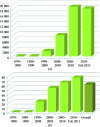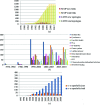Molecular replacement then and now
- PMID: 24189239
- PMCID: PMC3817701
- DOI: 10.1107/S0907444913011426
Molecular replacement then and now
Abstract
The `phase problem' in crystallography results from the inability to directly measure the phases of individual diffracted X-ray waves. While intensities are directly measured during data collection, phases must be obtained by other means. Several phasing methods are available (MIR, SAR, MAD, SAD and MR) and they all rely on the premise that phase information can be obtained if the positions of marker atoms in the unknown crystal structure are known. This paper is dedicated to the most popular phasing method, molecular replacement (MR), and represents a personal overview of the development, use and requirements of the methodology. The first description of noncrystallographic symmetry as a tool for structure determination was explained by Rossmann and Blow [Rossmann & Blow (1962), Acta Cryst. 15, 24-31]. The term `molecular replacement' was introduced as the name of a book in which the early papers were collected and briefly reviewed [Rossmann (1972), The Molecular Replacement Method. New York: Gordon & Breach]. Several programs have evolved from the original concept to allow faster and more sophisticated searches, including six-dimensional searches and brute-force approaches. While careful selection of the resolution range for the search and the quality of the data will greatly influence the outcome, the correct choice of the search model is probably still the main criterion to guarantee success in solving a structure using MR. Two of the main parameters used to define the `best' search model are sequence identity (25% or more) and structural similarity. Another parameter that may often be undervalued is the quality of the probe: there is clearly a relationship between the quality and the correctness of the chosen probe and its usefulness as a search model. Efforts should be made by all structural biologists to ensure that their deposited structures, which are potential search probes for future systems, are of the best possible quality.
Keywords: accuracy; models; molecular replacement; quality.
Figures





Similar articles
-
The phase problem.Acta Crystallogr D Biol Crystallogr. 2003 Nov;59(Pt 11):1881-90. doi: 10.1107/s0907444903017815. Epub 2003 Oct 23. Acta Crystallogr D Biol Crystallogr. 2003. PMID: 14573942 Review.
-
Introduction to phasing.Acta Crystallogr D Biol Crystallogr. 2010 Apr;66(Pt 4):325-38. doi: 10.1107/S0907444910006694. Epub 2010 Mar 24. Acta Crystallogr D Biol Crystallogr. 2010. PMID: 20382985 Free PMC article.
-
SIMBAD: a sequence-independent molecular-replacement pipeline.Acta Crystallogr D Struct Biol. 2018 Jul 1;74(Pt 7):595-605. doi: 10.1107/S2059798318005752. Epub 2018 Jun 8. Acta Crystallogr D Struct Biol. 2018. PMID: 29968670 Free PMC article.
-
Molecular replacement: tricks and treats.Acta Crystallogr D Biol Crystallogr. 2013 Nov;69(Pt 11):2167-73. doi: 10.1107/S0907444913015291. Epub 2013 Oct 12. Acta Crystallogr D Biol Crystallogr. 2013. PMID: 24189227 Free PMC article. Review.
-
Facing the phase problem.IUCrJ. 2023 Sep 1;10(Pt 5):521-543. doi: 10.1107/S2052252523006449. IUCrJ. 2023. PMID: 37668214 Free PMC article.
Cited by
-
Predicted models and CCP4.Acta Crystallogr D Struct Biol. 2023 Sep 1;79(Pt 9):806-819. doi: 10.1107/S2059798323006289. Epub 2023 Aug 17. Acta Crystallogr D Struct Biol. 2023. PMID: 37594303 Free PMC article.
-
Crystallographic molecular replacement using an in silico-generated search model of SARS-CoV-2 ORF8.Protein Sci. 2021 Apr;30(4):728-734. doi: 10.1002/pro.4050. Epub 2021 Mar 4. Protein Sci. 2021. PMID: 33625752 Free PMC article.
-
Protein Crystallography in Vaccine Research and Development.Int J Mol Sci. 2015 Jun 9;16(6):13106-40. doi: 10.3390/ijms160613106. Int J Mol Sci. 2015. PMID: 26068237 Free PMC article. Review.
-
A general method for directly phasing diffraction data from high-solvent-content protein crystals.IUCrJ. 2022 Aug 13;9(Pt 5):648-665. doi: 10.1107/S2052252522006996. eCollection 2022 Sep 1. IUCrJ. 2022. PMID: 36071801 Free PMC article.
-
High-accuracy protein structures by combining machine-learning with physics-based refinement.Proteins. 2020 May;88(5):637-642. doi: 10.1002/prot.25847. Epub 2019 Nov 15. Proteins. 2020. PMID: 31693199 Free PMC article.
References
-
- Adams, P. D. et al. (2010). Acta Cryst. D66, 213–221. - PubMed
Publication types
MeSH terms
Substances
LinkOut - more resources
Full Text Sources
Other Literature Sources
Miscellaneous

